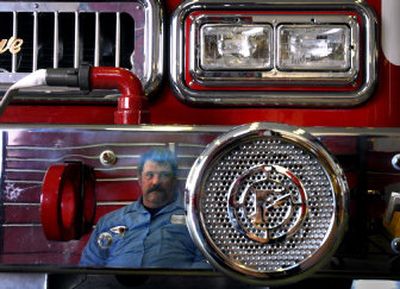New firetruck’s siren a throwback

In the mechanics garage of the Spokane Valley Fire Department, there’s a firetruck with a sticker price considerably higher than one might pay for a Maserati.
There’s a remote-controlled water cannon on its roof that can fire 1,000 gallons a minute. Its 150-watt floodlights can make any midnight fire site look like Friday afternoon. There’s 475 horsepower under the hood and a metal-plated cab that would make a battleship admiral jealous.
Even in a fleet of vehicles decked out with bells and whistles, this truck, a 2006 Seagrave Rescue Pumper priced at $424,000, stands out. Its most unusual feature though, is not so state of the art. Instead, the pumper’s real unique feature is old, as in older than the spots on a Dalmatian. The Q siren mounted to the front bumper is a model mostly unchanged for almost a century. Its wail starts as a high-pitched nasal moan, then races as a simple motor twirls a slotted disc ever faster. The voice of the Q siren is the scream of nostalgia, the frantic howl played endlessly in black and white movies and 1950s police shows like “Highway Patrol.”
“It’s just a peculiar sound and when you hear it, you know it’s a firetruck,” said Gordon Schoonmaker, Spokane Valley Fire’s fleet operations supervisor.
It was Schoonmaker who made sure the department’s first new truck in two years had a Q siren mounted to its front bumper. Three more new trucks similar in size and purpose to the new Seagrave will roll into Schoonmaker’s shop this winter. Those three will be sporting the old Q sirens, too.
The truck now in the garage rolls onto the job Sept. 27 and its strange yowl is sure to have people looking for a faded red jalopy with splintered wooden ladders strapped to its fenders. And getting people to take notice is the point of going back to Q sirens.
Firefighters say electronic sirens no longer jar the public into action as they once did. A bright red ladder truck races down the street, emitting bursts of red and white light that bounce off every building and every person in the truck’s path. But fewer people take note as the truck’s speaker yelps of pending disaster.
Other motorists react in odd ways, by racing ahead to the next intersection to make turns uninterrupted, or by tailing the truck as if it were some rolling lottery ticket granting green lights, provided they can keep up.
There’s reason to believe that car cabins have become so quiet, so insulating, that people no longer hear sirens, which is the explanation Schoonmaker likes. Other firefighters tell stories of actually being raced en route to a fire by other drivers.
Long ago, when a firetruck barreled down the street, cars traveling in both directions pulled over to the right and stopped so the engines could get by, which is the law. The Q sirens let out one long howl, almost fading entirely before firefighters gave its slotted disk another spin for a fresh cry.
Schoonmaker’s betting there’s still a little magic left in the old-style noisemaker. The 2006 Seagrave will be dispatched at the 11th Avenue and Evergreen Road fire station in 16 days. He’ll have his answer soon.